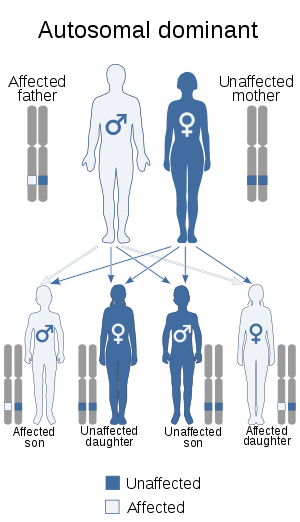Blepharophimosis, ptosis, epicanthus inversus syndrome
| Blepharophimosis, ptosis, epicanthus inversus syndrome | |
|---|---|
| Synonyms | Blepharophimosis types 1 and 2 |
 | |
| Blepharophimosis, ptosis, epicanthus inversus syndrome is inherited in an autosomal dominant manner | |
Blepharophimosis, ptosis, epicanthus inversus syndrome or BPES is a rare disease characterized by the conditions it is named after: blepharophimosis, ptosis, and epicanthus inversus.
Signs and symptoms
The most prominent symptoms of BPES are horizontally narrow eyes (blepharophimosis), drooping eyelids (ptosis), and a fold of skin running from the side of the nose to the lower eyelid (epicanthus inversus). Other common symptoms include lack of an eyelid fold, widely spaced eyes (telecanthus), low nose bridge, and ear malformations (including cupping and incomplete development). Rare symptoms include microphthalmos (abnormally small eyes), tear ducts in the wrong location, and high arched palate. Female infertility can occur with type I BPES.[1]
Genetics
BPES is caused by a mutation in the gene FOXL2 located at 3q23 (band 23 on the long arm of chromosome 3). There are two types, caused by different mutations in this gene, but both follow an autosomal dominant pattern of inheritance.[1]
Diagnosis
Though BPES can be suggested by the presence of blepharophimosis, ptosis, and/or epicanthus inversus, it can only be definitively diagnosed by genetic testing. Other disorders that appear similar include Waardenburg syndrome and Ohdo blepharophimosis syndrome.[1]
Treatment
The main treatment is symptomatic, since the underlying genetic defect cannot be corrected as of 2015. Symptomatic treatment is surgical.[1]
Epidemiology
BPES is very rare: only 50-100 cases have been described. It affects slightly more males than females.[1]
References
External links
| Classification | |
|---|---|
| External resources |